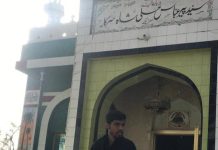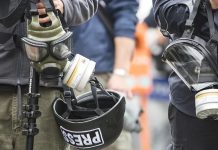Peshawar: Shafiq Khan, a retired army officer, used to know exactly which shopping precinct he wanted to go and where to park his car on Peshawar’s University Road. These days, he says, he often misses the shopping centres or shops because the city roads have become a tangle of buildings and arcades.
“Once, with fewer buildings, it was easy to spot the place you wanted to go,” says Khan. “Now they crop up like mushrooms after rain and are just as hard to tell apart from each other.”
While citizens like Khan, used to the less cluttered world of yesterday, may feel lost in a city that is expanding both vertically and horizontally, the provincial authorities are becoming increasingly concerned about another aspect of development.
As builders respond to accommodate business and housing needs of a rapidly growing population, multi-storey buildings have mushroomed in Peshawar, causing safety concerns as builders ignore building by-laws, according to provincial development authorities.
“Ignorance and violation on part of builders and failure on part of administrators in the past to implement building by-laws is resulting in safety hazards,” an official at the Peshawar Development Authority told News Lens Pakistan on the condition of anonymity because he was not authorized to speak to media.
Building bylaws, a set of building regulations enforced by Peshawar Development Authority (PDA), require every building to have, among other provisions, a car-parking lot, emergency exit area, fire extinguishing system, an adequate and functioning sanitation system and facilities for people who are physically challenged.
In recent months, the provincial authorities have come down hard on businesses like schools and restaurants in residential areas and shops that have encroached on roads and public spaces. Part of this elaborate cleaning up exercise include cracking down on owners of multi-storey buildings that have parking lots on the premises but have been turned into shops or commercial areas. This has led to people parking their cars out on the roads, choking traffic and often leading to accidents.
According to documents provided to News Lens Pakistan by Kamran Zaka, who is control room incharge at the Emergency Rescue Service (ERS) 1122 Peshawar, 449 fire breakouts were reported in the year 2015 at different places including multi-storey apartments and buildings, causing loss to property and precious lives because safety standards are not in place.
“Many a time, a small fire turns into a conflagration, causing a big loss to human lives and property because of absence of firefighting systems in multi-storey apartments, commercial buildings and factories,” said Muhammad Ayaz, Director Operations at the Peshawar headquarters of ERS 1122.
The PDA building bylaws requires commercial and residential buildings to have firefighting systems in the form of fire extinguishers, sand buckets, hydrants and emergency exit corridors.
“The number of buildings in the entire city with proper fire extinguishing systems and emergency exit corridors is less than one percent,” said Ayaz.
A research study titled “Expansion of Built up Area and its Impact on Urban Agriculture: A case study of Peshawar” says that being the largest city of Khyber Pakhtunkhwa, Peshawar has been a commercial hub and a focus of rural-urban migration. Due to its potential for employment and livelihood opportunities, it has been a preferred setting for internally displaced people from tribal areas and refugees from Afghanistan due to conflict. Due to this, says the study conducted by Sami Ullah, a research scholar at University of Peshawar, the population of the city has grown exponentially for the past few decades.
Population growth in a limited urban space has made construction in the city go vertical to meet the demand for residential, commercial and industrial needs, says the study. According to UNdata, Peshawar is the ninth largest city of Pakistan, with a population of nearly a million, as per the 1998 census. In absence of recent census, projections for population figures vary, with the authorities putting the number at 4 million now. In addition to this, Peshawar and its suburbs – along with Quetta and other border towns in Balochistan – have been home to the nearly 4.5million refugees from Afghanistan during the several stages of conflict and displacement from that country.
Director of Building Control Authority in Peshawar, Najeeb Ur Rahman, told News Lens that their teams were raiding buildings in parts of city and in stages to implement building by-laws. He said the raids were conducted in collaboration with the district administration.
When asked, Sajid Nawaz, the Public Relations Officer (PRO) at the Deputy Commissioner’s office in Peshawar, said the buildings that have been violating PDA bylaws will be dealt with “later.” However, he had no plan as to how and when.
“Currently we are just focusing on the parking issue in buildings as it is big problem not only in itself but also one that causes traffic problems,” said Nawaz. “We are also making sure that parking at dedicated areas of buildings is free of cost as the law prescribes.”
Among the neighbourhoods that have seen considerable commercial expansion in recent years is the Warsak Road in Peshawar. Murad Ali, who owns a two-storey building at Warsak Road said he had turned the parking area in the basement of the building into shops as it was not being used for parking.
“People park their vehicles outside the building to save time,” said Ali.
This tendency on part of people to violate parking rules, in addition to violation of bylaws by building owners and builders, has translated into massive traffic problems. For example, says Saddam Khan, a resident of inner city in Peshawar, “there is a dire need for multi-storey parking plazas in the crowded inner city to resolve the parking problem.”
A majority of the buildings in the city also lack arrangements to facilitate the physically disabled people.
“I can move freely everywhere in the city on my electric wheelchair but when it comes to high rises, I depend on others to help me move around,” says Sajad Ahmad, who lost both his legs to polio virus. “I face difficulty entering or exiting such buildings.”



